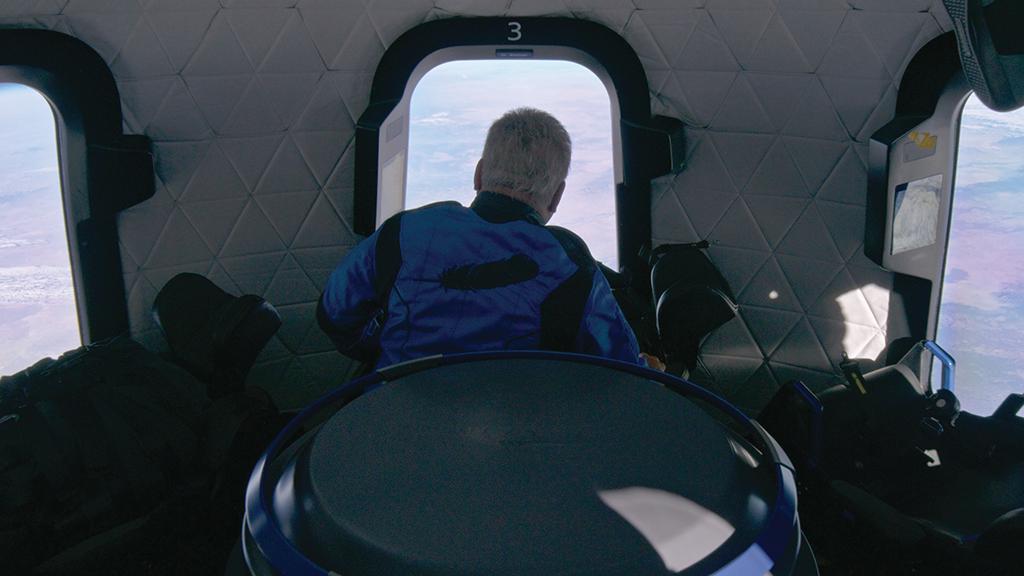
In 1966, as the U.S. and the Soviet Union raced to land men on the Moon, William Shatner, a 35-year-old Canadian actor, assumed the role of Capt. James T. Kirk in the science-fiction TV series “Star Trek.”
In command of the USS Enterprise, Shatner led a cast that depicted the use of advanced space technology—replicators, tricorders, faster-than-light travel—to explore a multicultural, multiracial universe. Six weeks after the 79th and final episode of the original series aired, the Apollo 11 astronauts lifted off for the Moon.
- Actor struck by blue of Earth
- “You’re through it in an instant”
Shatner—divorced, broke—did not think much of the space program at the time, but as the “Star Trek” franchise grew, Kirk became his fictional doppelganger.
Fifty-five years later, the roles reversed, and it was Shatner, not Kirk, heading into space, courtesy of sci-fi aficionado Jeff Bezos, founder and financier of the Blue Origin space company.
When Blue Origin’s New Shepard capsule returned from its autonomous 10-min. ride into suborbital space on Oct. 13, the company’s second flight with passengers aboard, Bezos was there to open the hatch, greet the crew and hear Shatner’s first words.
It was the depth and shine of blue light radiating from Earth that hit Shatner first, a visceral experience triggered by the contrast with black space.
“The covering of blue, this sheet, this blanket, this comforter of blue that we have around us—we think, ‘Oh, that’s blue sky,’ . . . and then you rip off the sheet and you’re looking in blackness, black, ugliness,” Shatner told Bezos.
The conversation was broadcast as part of Blue Origin’s live mission coverage.
“You look down, and there’s the blue. And it’s the black up there,” Shatner said. “There is mother, Earth and comfort. And there . . . is there death? Is that the way death is?
“It was so moving to me,” Shatner added. “This experience is something unbelievable.”
Shatner noted the effects of microgravity—“My stomach went up and I thought: ‘God, this is so weird,’”—but he quickly returned to his observations of Earth.
“This covering of blue, this is what I never expected,” he told Bezos. “There is this pillow, this soft blue. [You] look at the beauty of that color, and it’s so thin. You’re through it in an instant . . . and you’re into black.
“What I would love to do is to communicate as much as possible the jeopardy, the vulnerability of . . . this air, which is keeping us alive,” Shatner said. “It’s thinner than your skin. It’s immeasurably small when you think in terms of the universe. I am overwhelmed. I had no idea.”
A few hours later, the actor and his crewmates—Blue Origin Vice President Audrey Powers and paying passengers Chris Boshuizen and Glen de Vries—met with reporters at the edge of the pad where the New Shepard propulsion module touched down after sending them to space.
Asked if he would want to fly again, Shatner replied, “I am so filled with such emotion and the feeling of [a] novel experience, I don’t want to dissipate, dilute, it by thinking of another journey.”
Shatner was Bezos’ third guest to experience spaceflight. Bezos invited his brother, Mark Bezos, and aviation pioneer Wally Funk to accompany him aboard the New Shepard for Blue Origin’s first crewed flight in July. Three paying passengers and one company employee also have flown. Another four yet-to-be-named passengers are expected to fly in December.
Blue Origin plans to begin flying six-passenger crews next year. The company has not disclosed pricing.





